Dogs licking their owner’s faces is a behavior that many dog owners are familiar with, but have you ever wondered why they do it? There are several reasons why dogs engage in this behavior, and understanding them can help deepen your bond with your furry friend.
Instinctual Behavior:
- Maternal Instincts: Dogs may lick your face as a way to show their maternal instincts, mimicking how a mother dog would groom her puppies.
- Social Bonding: Licking is a form of social bonding among dogs, and they may transfer this behavior to their human companions as a way to strengthen the bond between them.
- Mutual Grooming: Dogs also lick as a way of engaging in mutual grooming, signaling trust and forming social connections.
Communication and Affection:
- Showing Submission: Licking can be a sign of submission, as dogs may lick their owner’s face to show respect and acknowledge their higher status.
- Displaying Affection: Licking is often a display of affection from dogs, showing that they care for and love their owners.
- Marking Territory: Dogs have scent glands in their mouths, and licking their owner’s face can be a way for them to mark you as part of their territory.
Health and Well-being:
- Seeking Salt and Minerals: Dogs may lick your face if they are seeking the taste of salt or minerals present on your skin.
- Relieving Stress and Anxiety: Licking can have a calming effect on dogs, and it can be a self-soothing behavior that helps them relieve stress or anxiety.
- Keeping Clean: Dogs have natural grooming instincts, and they may lick your face as a way to help keep you clean, similar to how they groom themselves.
Training and Reinforcement:
- Early Conditioning: If dogs are encouraged or rewarded for licking behavior as puppies, they may continue this behavior into adulthood.
- Positive Reinforcement: Dogs can learn that licking behavior leads to attention and affection from their owners, reinforcing the behavior.
Managing and Redirecting Licking Behavior:
- Setting Boundaries and Consistency: Establish clear boundaries for when licking is acceptable and when it is not, and be consistent in enforcing these boundaries.
- Providing Appropriate Alternatives: Offer your dog appropriate alternatives to lick, such as dog-friendly toys or treats, to redirect their licking behavior.
- Seeking Professional Help if Needed: If your dog’s licking behavior becomes excessive or problematic, it may be beneficial to seek guidance from a professional dog trainer or behaviorist.
By understanding the reasons behind why dogs lick your face, you can better interpret their behavior and strengthen the bond between you and your canine companion.
Key takeaway:
- Dogs lick your face due to instinctual behavior: Licking can be a result of maternal instincts, social bonding, and mutual grooming.
- Licking is communication and affection: Dogs may lick your face to show submission, display affection, or mark their territory.
- Licking is related to health and well-being: Dogs may lick your face to seek salt and minerals, relieve stress and anxiety, and maintain cleanliness.
Why Do Dogs Lick Your Face?
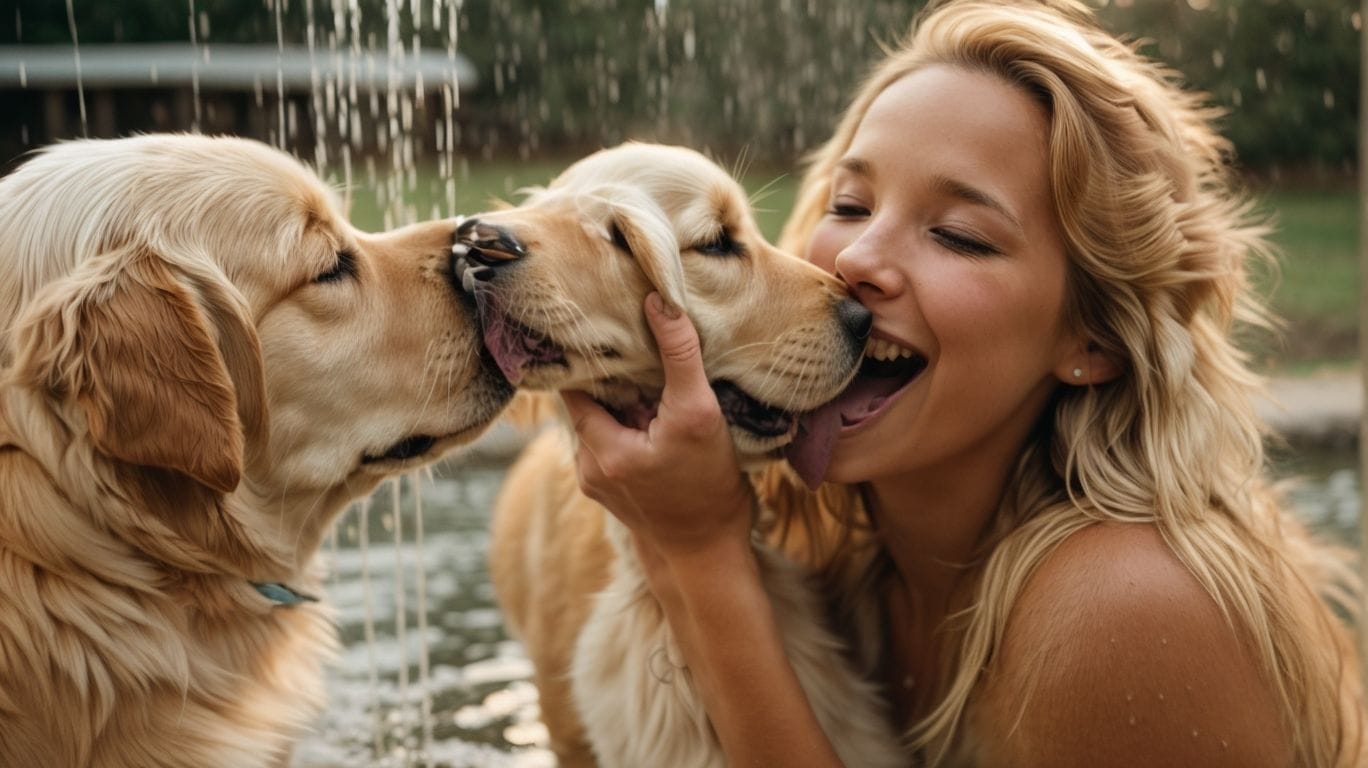
Photo Credits: Petnarnia.Com by Jose Green
Why Do Dogs Lick Your Face?
Dogs lick faces for various reasons, and understanding why they do so can deepen our bond with our furry friends. Dogs communicate through body language, and licking is a way for them to express affection, seek attention, or show submission. Additionally, dogs lick to explore and gather information through taste and scent. It’s important to note that not all dogs engage in face licking, and each dog’s behavior may vary. Historical records suggest that dogs licking human faces dates back to ancient times when dogs were domesticated and developed strong emotional connections with their human companions. So, the next time your dog licks your face, you’ll have a better understanding of the multiple reasons behind this behavior.
Instinctual Behavior
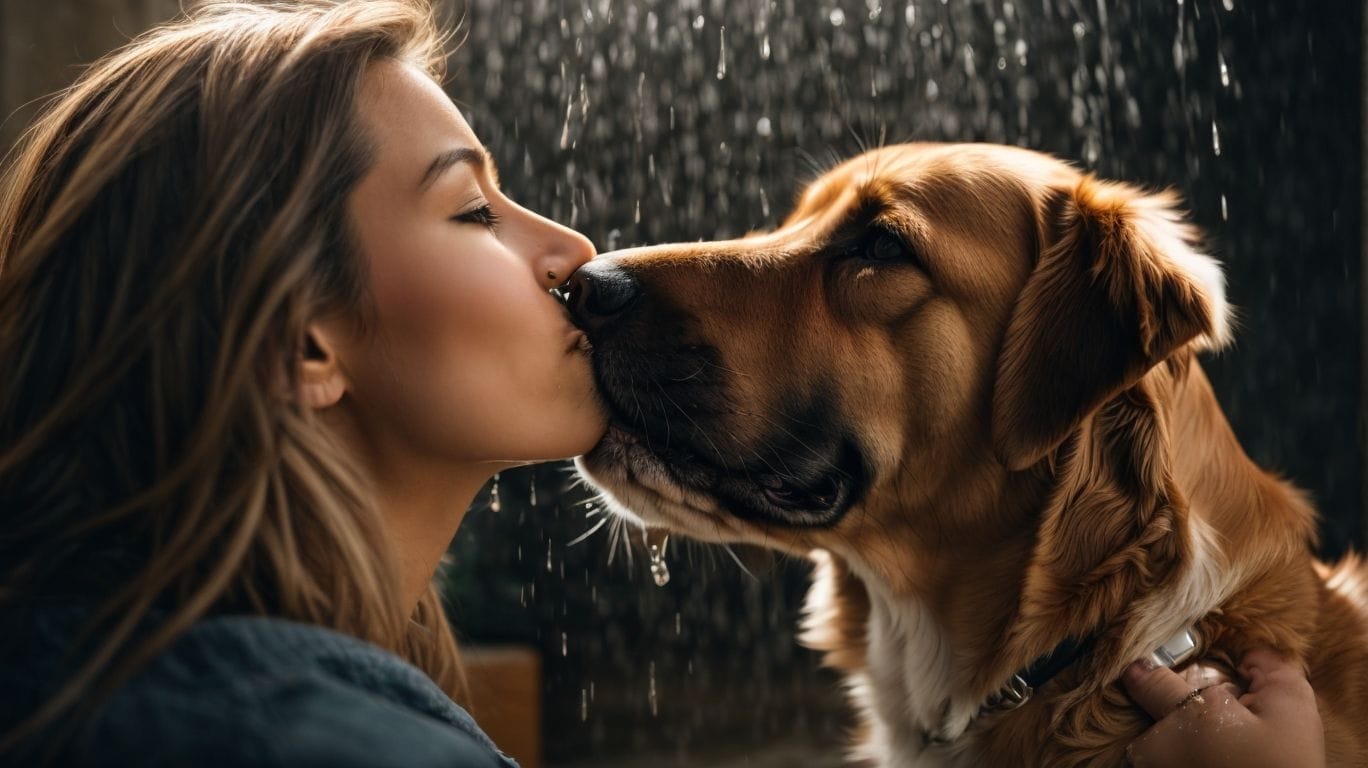
Photo Credits: Petnarnia.Com by Frank Flores
As we explore the instinctual behavior of dogs, we unravel fascinating sub-sections that shed light on their habits. From their maternal instincts to social bonding and the intriguing concept of mutual grooming, we dive into the intricate world of why our furry friends can’t resist licking our faces. So, get ready to uncover the hidden instincts behind this adorable yet puzzling behavior of our canine companions.Maternal Instincts
Maternal instincts play a critical role in why dogs lick your face. This instinctive behavior is inherited from their wolf ancestors. When a mother dog licks her puppies, it serves multiple purposes. It helps stimulate their senses and foster bonding. The act of licking aids in cleaning the puppies and eliminating any potential threats or parasites. This maternal behavior can also be observed in adult dogs towards their human owners or other animals in the household. It is a way for them to demonstrate affection, care, and establish their social hierarchy within the pack. Maternal instincts are an intrinsic part of a dog’s behavior and contribute to their overall well-being and communication.
Social Bonding
In dogs, licking serves as a natural way to strengthen social bonding between individuals. It is a common behavior that fulfills various purposes:
- 1. Establishing Trust: Licking is a way for dogs to show affection and build trust in their social relationships.
- 2. Reinforcing Hierarchy: Dogs may lick the faces of higher-ranking individuals as a sign of submission and respect, thereby enhancing social bonding.
- 3. Strengthening Pack Dynamics: Licking acts as a form of mutual grooming that helps maintain social harmony within a pack, promoting social bonding.
- 4. Communicating Needs: Dogs may lick their owners’ faces to indicate their needs or to seek attention, fostering social bonding.
If your dog’s licking becomes excessive or bothersome, providing appropriate alternatives like chew toys or seeking professional help can help redirect this behavior.
Mutual Grooming
Mutual grooming is a natural behavior in dogs that serves multiple purposes, including bonding, social communication, and hygiene maintenance.
- Bonding: Dogs engage in mutual grooming to strengthen their social bonds with other dogs or humans.
- Communication: Mutual grooming is a way for dogs to communicate affection and submission to each other.
- Hygiene: This behavior helps to keep dogs clean by removing dirt, debris, and parasites from their fur.
In a similar vein, I have a heartwarming story to share. It involves two rescue dogs, who developed a close bond through mutual grooming. Despite their difficult pasts, they found comfort and solace in each other, demonstrating the power of this instinctual behavior.
Communication and Affection
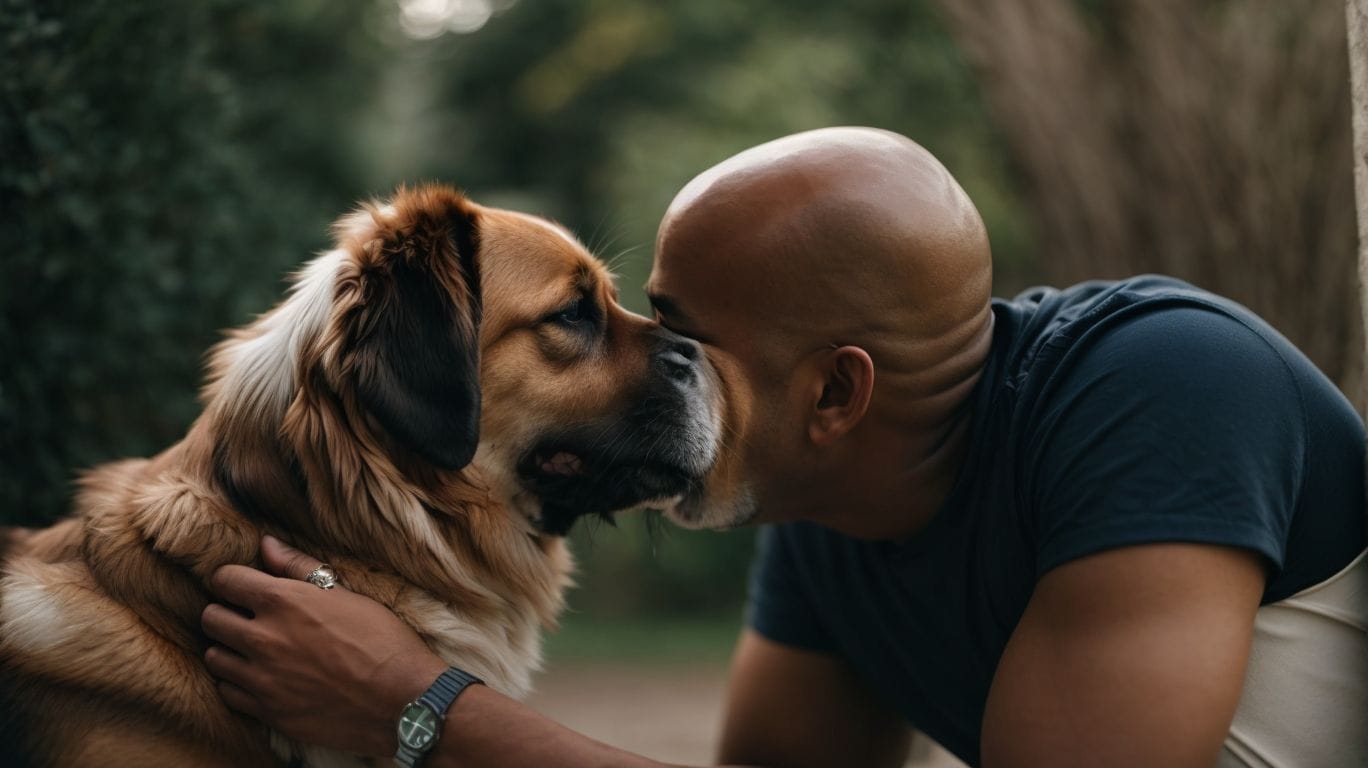
Photo Credits: Petnarnia.Com by Keith Brown
When it comes to understanding why dogs lick our faces, communication and affection play a crucial role. In this section, we’ll delve into the various ways dogs communicate through licking, such as showing submission, displaying affection, and marking territory. Get ready to unravel the fascinating ways in which this simple act of licking connects dogs with their human counterparts. So, why do dogs insist on showering us with licks? Let’s find out!Showing Submission
Dogs may lick your face as a way of showing submission. This behavior is instinctual and can be traced back to their pack mentality. By licking your face, they are demonstrating their deference to you as the dominant member of the pack. This submissive gesture is a natural way for dogs to acknowledge your authority and establish a harmonious relationship. It’s important to set boundaries and provide consistent training to manage and redirect excessive licking behavior. If the licking behavior becomes problematic, seeking professional help is recommended.
Displaying Affection
Displaying affection is one of the reasons why dogs lick your face. It is their way of showing love and bonding with their owners. This behavior can be seen in several different ways:
- Wedding: Dogs may lick your face as a sign of submission and respect, similar to how they would greet an alpha dog in their pack.
- Affection: Licking can be a way for dogs to express their love and affection for their owners.
- Territory: Dogs may also lick your face to mark their territory, leaving their scent behind.
Understanding these different motivations behind licking can help you better interpret and respond to your dog’s behavior.
Marking Territory
Marking territory is one of the reasons why dogs engage in the behavior of licking your face. It is an innate action that can be traced back to their ancestral background. When dogs lick your face, they are actually leaving their scent, acting as a territorial marker. This behavior also serves as a means of showcasing dominance and asserting their presence. Dogs possess scent glands in their mouths, so by licking, they are able to spread their unique scent. Hence, the next time your beloved dog licks your face, always keep in mind that it is their way of marking you as their own and establishing their territory.
Health and Well-being
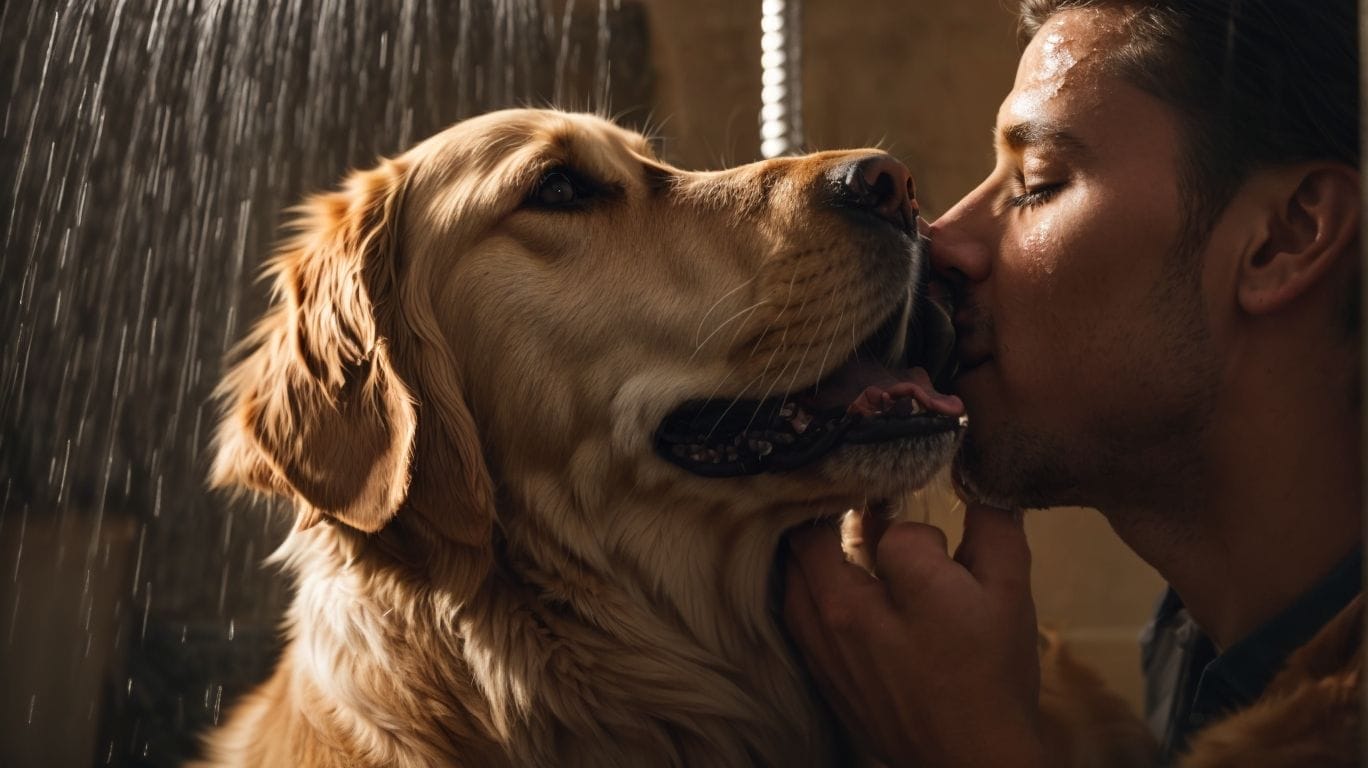
Photo Credits: Petnarnia.Com by Dylan Lewis
When it comes to our furry friends licking our faces, there’s more to it than just affection. In the Health and Well-being realm, we’ll explore the fascinating reasons behind this behavior. From seeking essential minerals and salt to relieving stress and anxiety, our dogs have their unique ways of taking care of themselves. Join us as we delve into the surprising ways our canine companions keep themselves healthy and clean.Seeking Salt and Minerals
Seeking salt and minerals is one of the reasons why dogs lick your face. Dogs have an innate instinct to seek out salt and minerals to supplement their diet. Licking your face allows them to access sweat, which contains salt. Dogs may also lick your face to obtain minerals that they may be lacking in their diet. It’s important to provide a well-balanced diet to ensure that your dog is getting all the necessary nutrients and minerals.
Relieving Stress and Anxiety
Relieving stress and anxiety is one of the reasons why dogs lick your face. This behavior serves as a natural coping mechanism for dogs in challenging or overwhelming situations. Here are some ways that dogs relieve stress and anxiety through licking:
| Calming Effect | Sensory Stimulation | Bonding and Comfort |
|---|---|---|
| Licking helps dogs feel more relaxed and reduces their stress levels by releasing endorphins. | Licking provides dogs with sensory stimulation that distracts them from anxious thoughts due to its repetitive and rhythmic motion. | Licking promotes bonding with their owners and eases feelings of anxiety, offering dogs a sense of security and comfort. |
Keeping Clean
Keeping clean is one of the reasons why dogs lick your face. Here are a few steps to understand this behavior:
- Grooming instinct: Dogs have an inherent instinct to groom themselves and others, in order to keep clean. Licking serves as a means to eliminate dirt, debris, and odor.
- Maintaining hygiene: Through licking, dogs are able to uphold their own fur as well as the fur of other dogs or humans they regularly interact with, thereby keeping clean.
- Cleaning wounds: Dogs possess natural antiseptic properties in their saliva, so they may lick wounds for the purpose of keeping them clean and fostering healing.
- Removing food particles: Dogs may lick your face to eradicate food particles or crumbs, ensuring cleanliness.
- Expressing affection: Licking can be a gesture for dogs to display love and affection, similar to how they groom their pack members, thus keeping clean in a social and emotional sense.
Training and Reinforcement
When it comes to understanding why dogs lick our faces, one key aspect to explore is training and reinforcement. In this section, we’ll dive into the fascinating realm of early conditioning and the power of positive reinforcement. Get ready to uncover the secrets behind how dogs learn and what drives their behavior, backed up by some intriguing facts and real-life examples. Prepare to be amazed as we unravel the science behind training our furry friends!Early Conditioning
Early conditioning plays an essential role in comprehending the reason behind dogs licking faces. It encompasses training and reinforcing desired behaviors right from the beginning stages of their life. By using positive reinforcement to encourage appropriate behavior, such as sitting or staying calm, dogs develop an association between these actions and rewards. Through early conditioning, dogs can be trained to lick faces only upon receiving a cue or command. This approach aids in setting boundaries and preventing unwanted behavior. Consistency and patience are crucial when implementing early conditioning, and consulting a professional can be advantageous if necessary.
Positive Reinforcement
Positive reinforcement is a highly effective method for training dogs and positively influencing their behavior. Here are several ways in which positive reinforcement can be utilized:
- Reward-based training: Utilize treats, praise, or playtime as rewards for desired behaviors, such as sitting or staying.
- Clicker training: Introduce a click sound along with treats or rewards to reinforce positive behavior.
- Consistency: Maintain consistency in rewarding positive behavior, reinforcing the connection between the behavior and the reward.
- Timing: Offer immediate reinforcement once a desired behavior is displayed, strengthening the association.
- Shaping: Employ incremental rewards to gradually shape and reinforce more complex behaviors.
Positive reinforcement assists dogs in associating desired behaviors with positive outcomes, thus making the training process more effective and enjoyable for both the dog and the owner.
Managing and Redirecting Licking Behavior
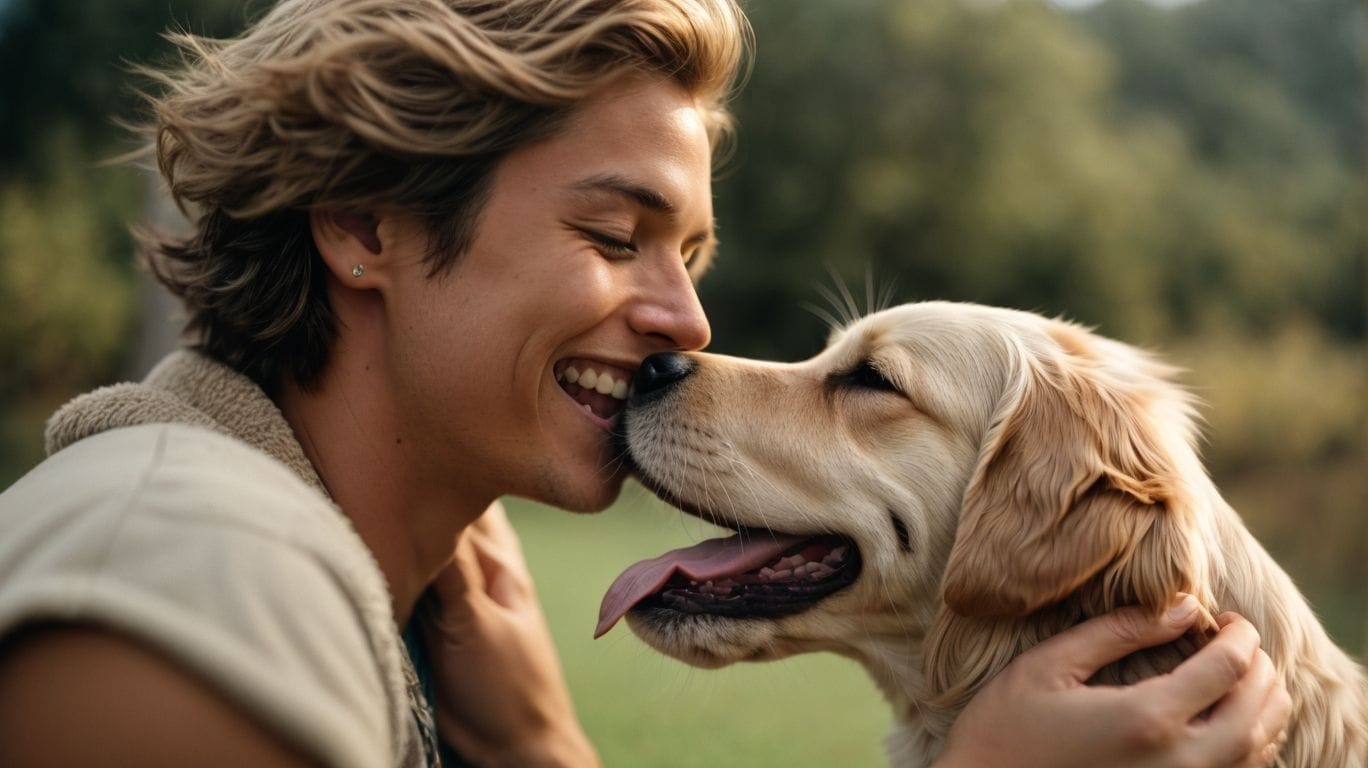
Photo Credits: Petnarnia.Com by Steven Moore
Finding ways to manage and redirect your dog’s licking behavior can be crucial for maintaining both their well-being and your own sanity. In this section, we will explore effective strategies to set boundaries and establish consistency in handling excessive licking. We will also discuss providing appropriate alternatives and seeking professional help if necessary. Get ready to tackle this common canine behavior and create a harmonious balance with your furry friend.Setting Boundaries and Consistency
Setting boundaries and consistency is crucial when managing and redirecting your dog’s licking behavior. Here are some strategies to consider:
Establish clear rules: Consistently communicate to your dog that face licking is not allowed.
Use firm commands: Teach your dog commands like “Stop” or “No licking” to reinforce the boundaries.
Redirect their energy: Provide alternative activities or toys to redirect their attention away from face licking.
Be consistent: Enforce the boundaries every time your dog tries to lick your face.
Pro-tip: Remember, consistency is key! By setting clear boundaries and following through with them, you can effectively manage your dog’s licking behavior and maintain a healthy relationship.
Providing Appropriate Alternatives
When it comes to managing and redirecting a dog’s face licking behavior, providing appropriate alternatives is crucial. Here are some suggestions:
1. Chew toys: Offer a variety of safe and durable chew toys to redirect your dog’s licking urge onto something appropriate.
2. Raw bones or dental treats: These can keep your dog occupied and satisfy their need for oral stimulation.
3. Interactive puzzles or toys: These mentally stimulating toys can engage your dog’s attention and redirect their licking behavior.
4. Training exercises: Teaching your dog alternative behaviors like sitting or offering a paw can redirect their focus away from face licking.
5. Enrichment activities: Engage your dog in physical activities, such as playing fetch or going for walks, to redirect their energy and prevent excessive licking.
Remember, consistency, positive reinforcement, and patience are key when providing appropriate alternatives to discourage face licking behavior in dogs.
Seeking Professional Help if Needed
If your dog’s face licking behavior becomes excessive or problematic, seeking professional help if needed may be necessary. Here are some steps to consider:
- Observe the frequency and intensity of the licking behavior.
- Consult with your veterinarian to rule out any underlying medical issues.
- Seeking the assistance of a professional dog trainer or behaviorist who specializes in licking behavior.
- Follow the guidance provided by the professional, which may include behavior modification techniques or training exercises.
Remember, seeking professional help if needed can provide valuable insights and solutions tailored to your dog’s specific needs.
Fun Fact: Did you know that dogs have a specialized organ in their noses called the vomeronasal organ, which helps them to detect and analyze different scents?
Some Facts About Why Do Dogs Lick Your Face:
- ✅ Dogs lick faces as a social behavior. It stems from their wolf puppy behavior of licking adult dogs’ mouths to prompt regurgitation of food.
- ✅ It can be a way for dogs to show affection and feel close to their owners. Licking releases endorphins and feel-good chemicals in the brain, making it pleasurable for dogs.
- ✅ Dogs may lick faces to solicit food or attention. It can be a way to communicate their needs to their owners.
- ✅ Licking faces can also be a sign of appeasement. Dogs may lick faces as a submissive gesture to show friendliness and reduce tension.
- ✅ Dogs may lick faces as part of grooming behavior. It can be a way to clean their owners’ faces, just like how they groom themselves and other dogs.


